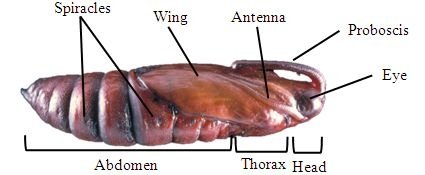
Much like how we all go through changes in life, hornworms experience a remarkable transformation called metamorphosis. But where exactly do they go during this secretive stage? Here’s the thing: they don’t just dig a hole and disappear. Instead, they embark on a specific journey that leads to their rebirth as beautiful moths. Let me explain the details of this hidden phase, so you’ll have a clearer picture of what goes on beneath the surface.
Understanding Hornworm Life Cycle
To appreciate the pupation process, it helps to grasp the entire life cycle of hornworms. These fascinating insects start their lives as eggs, usually laid on the leaves of host plants like tomatoes or eggplants. After a week or so, hatchling hornworms emerge. They’re tiny but grow rapidly, munching through leaves and gaining weight.
Once they’ve reached their full size, they prepare for the next step. This is where the fun begins! After about three to four weeks of feeding, hornworms ready themselves to pupate. They wander away from their host plants, seeking out a safe spot where they can undergo their big transformation.
Here’s a fun fact: hornworms can grow to be about 4 inches long! That’s quite a leap from their initial egg size. Once full-grown, they instinctively know it’s time to dig down deep, leaving behind their leafy buffet.
The Pupation Process Explained
So, now that the hornworm has left its plant, what happens next? This is where the underground adventure begins. The hornworm digs into the soil, creating a small chamber that will serve as its protective home during pupation. Think of it as a cozy little cave where they can safely undergo their transformation without being disturbed.
Inside the soil, the hornworm sheds its skin and turns into a pupa. This stage can take anywhere from a week to a month, depending on environmental factors like temperature and humidity. The pupae look pretty different from their former selves. They become a sort of hard casing, where all the magic happens.
During this time, while they seem dormant, their bodies are undergoing incredible changes. They’re essentially reformatting themselves from a caterpillar into a moth, preparing for their grand debut.
Where Do Hornworms Go Underground?
You might be wondering, “Where exactly do these hornworms go to pupate?” Well, hornworms typically dig a few inches down into loose, moist soil. This depth provides them with protection from predators and harsh weather. It’s essential that the soil is not too compact; otherwise, they’d struggle to dig and move around.
This underground home is crucial for their survival. It ensures the pupa remains safe and can undergo its delicate metamorphosis without interruption. Interestingly, hornworms are often found in gardens and farms, so if you’ve got loose garden soil, chances are good that they’re nearby, busy working on their transformation.
Signs of Pupation
If you’re keeping an eye on your garden, you might notice some signs that indicate hornworms are getting ready to pupate. First, you might see them wandering away from the plants they’ve been munching on. You may also spot them searching for loose soil, which can be anything from a garden bed to a pile of mulch.
Another sign is their behavior. Hornworms tend to become less active as they prepare for pupation. Instead of constantly eating, they start moving around more aimlessly. If you ever see a hornworm stopping to dig or burrow into the ground, it’s likely getting ready for its transformation.
Recognizing these behaviors can help you understand the natural process and keep track of your garden’s insect life cycle.
The Importance of Pupation in Nature
Pupation is not just a stage in the life of a hornworm; it plays a vital role in the ecosystem. As hornworms metamorphose into moths, they become part of the food chain. Adult moths are often prey for birds and other wildlife, contributing to the biodiversity within gardens and habitats.
Additionally, this process can also impact plant health. While hornworms munch on leaves as caterpillars, once they transition to moths, they help in pollination. So, in a way, their life cycle completes a circle that aids both the plants they feed on and their predators.
Also, it’s essential to remember that the more understanding we gain about these creatures, the better equipped we are to manage them in gardens. If you’re a gardener, knowing when hornworms are pupating can help you decide whether to let them be or take action if they become too plentiful.
How to Manage Hornworms in Your Garden
If you’ve got hornworms in your garden but want to keep your plants safe, here are some steps you can take to manage them:
- Handpicking: This is the simplest method. If you see them on your plants, just pluck them off and dispose of them.
- Beneficial Insects: Encourage natural predators like birds or parasitic wasps that specifically target hornworms.
- Natural Sprays: Consider using organic pesticides that are safe for the environment but effective against hornworm larvae.
By being proactive, you can help protect your plants while still appreciating the unique journey of hornworms.
Hornworm pupation is an incredible natural process that showcases the wonders of transformation in nature. Understanding where hornworms go underground helps us appreciate their journey from caterpillar to moth. Not only does this process enrich the ecosystem, but it also offers a glimpse into the intricate relationships between plants, insects, and their environment.
So, the next time you spot a hornworm in your garden, remember the wild adventure it will soon embark on underground. Embrace the cycle of life, and who knows? You might just find yourself more connected to your garden’s hidden treasures. Now that you know what happens below the surface, you can appreciate every stage of this beautiful transformation.
